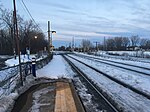Fort Senneville

Fort Senneville is one of the outlying forts of Montreal, Quebec, Canada, built by the Canadiens of New France near the Sainte-Anne-de-Bellevue in 1671. The property was part of a fief ceded to Dugué de Boisbriant in 1672 by the Sulpicians. A large stone windmill, which doubled as a watch tower, was built on a hill by late 1686 and featuring machicolation and other castle-like features. The fort was burned down by Iroquois in 1691, with only the mill itself left standing. Governor-General Frontenac ordered the construction of a second, more imposing fort in 1692. It was rebuilt in 1702–1703 to protect the nearby fur trading post. With extensive cannons and swiveling wall guns, it was the "most substantial castle-like fort" near Montreal. It was eventually destroyed in 1776 by Benedict Arnold, under American military control, but the ruins have been maintained since then. In 2003, it was classified as a historic site.
Excerpt from the Wikipedia article Fort Senneville (License: CC BY-SA 3.0, Authors, Images).Fort Senneville
40,
Geographical coordinates (GPS) Address External links Nearby Places Show on map
Geographical coordinates (GPS)
| Latitude | Longitude |
|---|---|
| N 45.42585 ° | E -73.974402 ° |
Address
Fort Senneville
40
H9X 3R3
Quebec, Canada
Open on Google Maps










